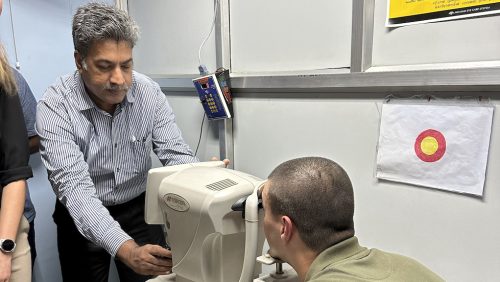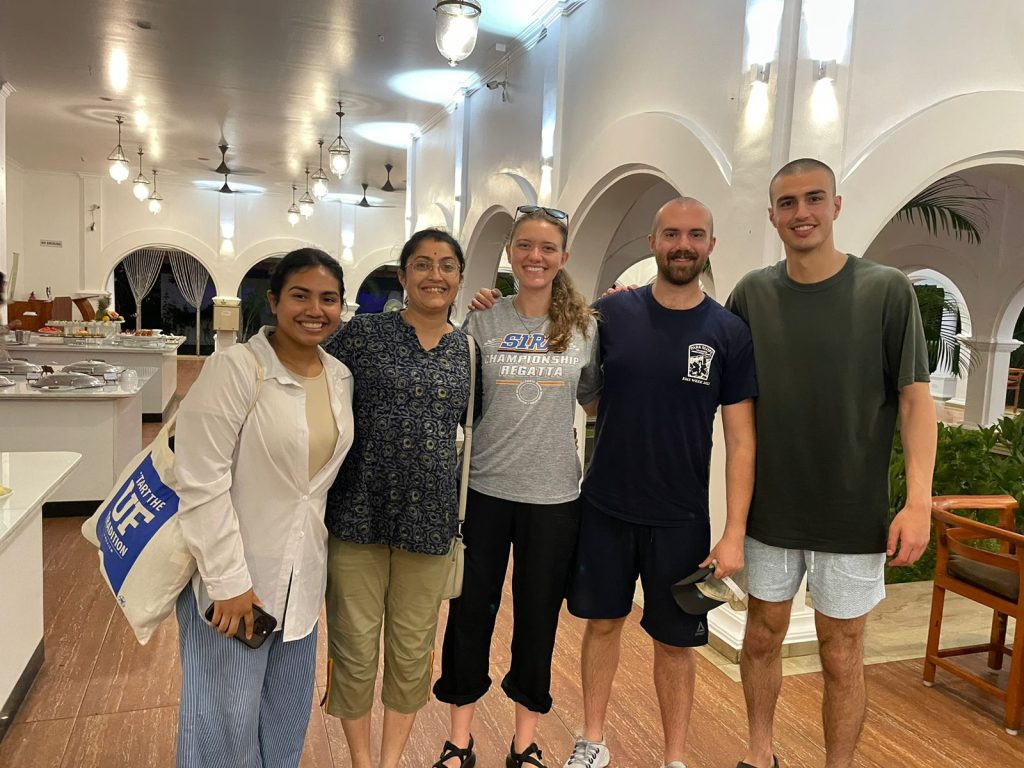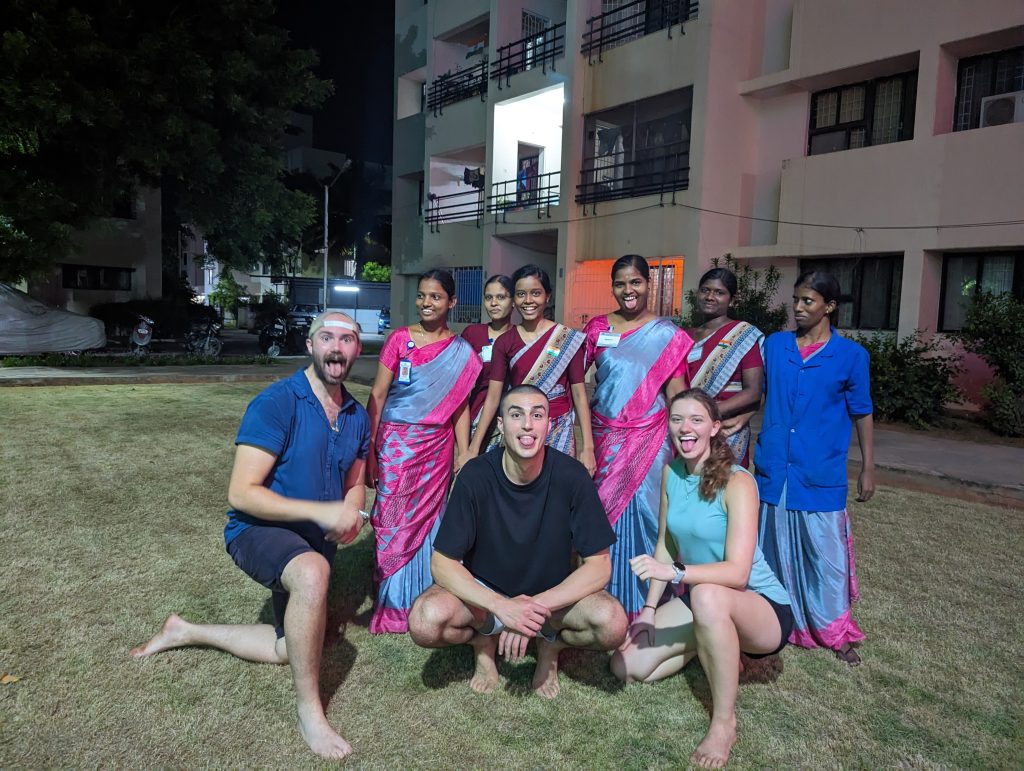
Partnering to Explore Unmet Needs in Glaucoma Care Pathway
By Ira Pundeer
The Johns Hopkins Center for Bioengineering Innovation & Design (CBID) and the Gupta-Klinsky India Institute (GKII) share a vision to develop impactful healthcare solutions that enhance the lives of patients, particularly in the context of India. Both organizations prioritize gaining a comprehensive understanding of patient and stakeholder needs, fostering iterative co-development of solutions to ensure their relevance and viability within the Indian healthcare ecosystem.
This year, our collaboration has expanded through a partnership with the Aravind Eye Care System, focusing on identifying unmet needs and crafting, testing, and validating a solution to prevent vision loss from glaucoma. In August 2023, GKII sponsored a team of CBID engineers to participate in a summer immersion program, engaging with the project on-site to deepen their insights. We sat down with the team members, Amina Ishrat, Lhotse Thompson, Sorush Rokui, and Luke Boyce, to learn more about their research and on-site experience.

What was the most unexpected or surprising aspect of your research journey in India, and how did it influence your perspective on healthcare and research?
We were fortunate enough to visit multiple campuses of the Aravind Eye Care System across Southern India. They are renowned for the incredible scale at which their clinical operations occur, serving many thousands every week. Nonetheless, seeing the sheer volume of patients served – in the operating theater and in the clinic – was remarkable. The quality with which that high volume care is delivered was, too, very impressive. Understanding the scale of their operations informed the remainder of our process of observation and solution development.
How have your interactions with local experts and professionals in the Indian healthcare field impacted your research methodology and approach?
Aravind features a tremendous breadth and depth of ophthalmologic expertise. Our project focuses on the treatment of glaucoma, a chronic and progressive condition affecting the large nerve at the back of the eye, usually due to high pressure in the front of the eye. Our interactions with the glaucoma subspecialists in Puducherry and Madurai – in the operating theater, clinic, and in dedicated interviews – were paramount in sharpening our understanding of the challenges with glaucoma treatment in general as well as in the Aravind population specifically. We are, indeed, indebted to them for their generous contribution of teaching and time.
Could you share a memorable encounter or interaction with individuals or communities in India that has left a lasting impression? How has this experience shaped your understanding of the healthcare challenges they face?
We had multiple memorable interactions during our time in India. We established a great relationship with a glaucoma surgeon named Dr. Swati who allowed us to watch her operate and conduct follow-up appointments on several occasions. Something that really stands out about Dr. Swati was how beautiful her operations were and how quickly the follow-up appointments were. Follow-ups were less than five minutes a patient where she was able to check on their eyes via slit lamp examination and other diagnostic methods. The quickness was imperative given the sheer volume of patients needed to be seen every day.
Another memorable moment would be the eye camp we attended. These camps occur every other Saturday across multiple locations throughout the region. The idea is to see as many people as they could (the one we went to saw 300+ patients in one day) and transport those who needed cataract surgery to the hospital that day. Because of the struggles with transportation for those who live rurally, these camps occur hours away from the hospital itself for increased accessibility. The day we attended, roughly 70 patients were given free transportation to the hospital for surgery.
We also had an unforgettable night on our last day in Puducherry. A group of us went to play spikeball and multiple “sisters” (female staff at the hospital) asked if they could join. They had never seen anything like it and loved learning how to play, even asking us to take a picture with them afterwards.

During your time conducting health research in India, what skills or qualities did you develop or enhance, and how do you envision applying them in your future endeavors?
We had the opportunity to hone skills that had been initially practiced earlier in the Summer during the team’s first stint rotating and observing at Johns Hopkins Medical Institutions. We learned how to prepare and study well so that we could communicate at as high a level as possible when working with experts. We learned how to observe keenly and take in as
much information as possible to better inform our team brainstorming and mind-mapping sessions that we would end each day with. With guidance from our mentor, Dr. Kunal Parikh, we developed our ability to derive impactful value from our interviews, our time observing procedures in the clinics as well as in the operating theater, and from our research. With all of these skills combine, we have been able to explore new and exciting areas within the realm of glaucoma treatment and hope to use the results of our experience in India with Aravind to create something that can really make a difference in the way glaucoma is treated and those suffering from the disease are cared for.
Were there specific cultural or logistical challenges you faced during your research in India, and if so, how did you overcome them? What valuable lessons did you learn from these challenges?
We were unbelievably fortunate to have been hosted by an organization like Aravind, and to have a mentor like Dr. Parikh with so much experience and so many connections he was willing to make for us to expedite our entire process of problem identification. Despite the team’s lack of ability to communicate in any of the country’s native languages, we were surrounded by accommodating and kind individuals the entire time and were able to engage at a high level with almost everyone we spoke with, sharing thoughts, meals and experiences.
Follow the team’s journey on Instagram: https://www.instagram.com/ophtho_cbid/